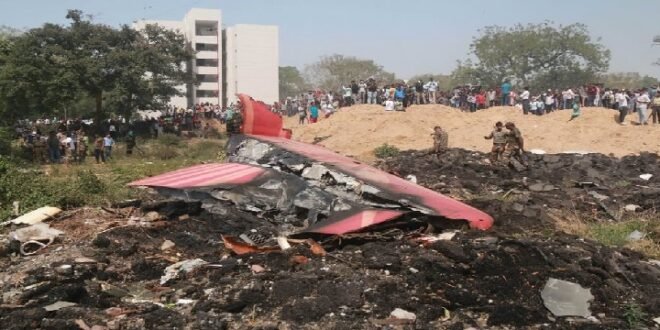13-07-2025
Bureau Report
NEW DELHI: Just moments before a fatal Air India crash on June 12, the Boeing 787 Dreamliner’s fuel-control switches in the cockpit mysteriously moved from the “run” to the “cutoff” position, an early investigation into the disaster has revealed.
Flipping to cutoff almost immediately cuts the engines. The investigation’s report, issued by India’s Aircraft Accident Investigation Bureau (AAIB) early on Saturday, found that both engines shut down within the space of one second, leading to immediate loss of altitude.
 The report does not conclude any reason for the switches moving or apportion blame for the crash of Air India’s Flight 171, which had been bound for London’s Gatwick Airport.
The report does not conclude any reason for the switches moving or apportion blame for the crash of Air India’s Flight 171, which had been bound for London’s Gatwick Airport.
Rather, the new details emerging from the report, including voice recordings from the cockpit, appear to have compounded the mystery about what caused the crash.
This is what the report has found and what we know about the final minute before the plane crashed.
At 13:38 (08:08 GMT) on the afternoon of June 12, the Dreamliner departed Ahmedabad for London Gatwick with 230 passengers, 10 cabin crew and 2 pilots on board.
Less than 40 seconds later, the aircraft lost both engines during its initial climb.
In the first such incident for a 787 Dreamliner, the plane crashed into the BJ Medical College hostel and adjoining structures in a densely populated suburb of the city, just under a nautical mile (equivalent to about 1.85km) from the runway.
The aircraft broke apart on impact, igniting a fire that destroyed parts of five buildings. All but one of the people on board the plane were killed. The sole survivor was Vishwaskumar Ramesh, a 40-year-old British national of Indian origin.
The AAIB, an office under India’s Ministry of Civil Aviation, is leading the probe into the world’s deadliest aviation accident in a decade. The probe is also joined by experts from Boeing and participants from the United States and United Kingdom.
 According to the preliminary report, the aircraft was deemed airworthy, with its Airworthiness Review Certificate valid until May 2026. Routine maintenance had been carried out, and no dangerous goods were on board.
According to the preliminary report, the aircraft was deemed airworthy, with its Airworthiness Review Certificate valid until May 2026. Routine maintenance had been carried out, and no dangerous goods were on board.
However, investigators noted a previous US Federal Aviation Administration (FAA) advisory from December 2018 regarding a potential flaw in the aircraft’s fuel-control switch system, highlighting the potential disengagement of the locking feature.
The report on the Air India crash noted that this advisory had been prompted by reports from operators of Boeing 737 aircraft, highlighting that fuel-control switches had been found to have been installed with their locking mechanisms disengaged.
Air India told the investigators that no inspection had been made in response to this SAIB, since compliance was not mandatory.
The report noted that the throttle control module on the aircraft had been replaced in 2019 and again in 2023. However, these replacements were not related to the fuel-control switch, and no defects concerning the switch have been reported since 2023, the report highlighted.
Key systems such as the Ram Air Turbine (RAT) and Auxiliary Power Unit (APU) were engaged and attempted automatic recovery, but only partial engine relight was achieved before the aircraft crashed.
What does the audio recording from the cockpit reveal?
Shortly after takeoff, both engines shut down almost simultaneously, as the fuel control switches inexplicably moved from “run” to “cutoff”.
Cockpit voice recordings captured one pilot questioning the other, “Why did you cut off?”
 Pressmediaofindia
Pressmediaofindia




